Biodiversity
Policy
Toyota Tsusho engages in sustainable business activities. The preservation of biodiversity is emphasized as a standard of sustainability.
We work to determine impacts of our business on biodiversity including the status of endangered species living in the vicinity of our business sites and specified information in protected areas, and in cases where there are negative impacts on ecosystems, we take measures to offset those impacts.
Disclosure Based on TNFD Recommendations
The Toyota Tsusho Group recognizes that natural capital, including biodiversity, is a prerequisite for the continuation of corporate activities. We acknowledge that our business activities, from raw material procurement through to manufacturing and sales in existing operations, as well as new investment and loan projects, both depend on and impact the blessings of nature. In 2024, we revised the Toyota Tsusho Group Environmental Policy by integrating the principles of the Toyota Tsusho Group Biodiversity Guidelines. Through the implementation of risk assessments for both new and existing businesses, appropriate responses in line with the mitigation hierarchy, and the establishment of traceability, we aim to balance biodiversity conservation with business activities in alignment with the Kunming-Montreal Global Biodiversity Framework and contribute to the realization of a nature-positive society.
In June 2021, the Taskforce on Nature-related Financial Disclosures (TNFD) was established as an international initiative to develop a framework for the proper assessment and disclosure of risks and opportunities related to natural capital and biodiversity. The Toyota Tsusho Group supports the principles of the TNFD and has been participating in the TNFD Forum, a stakeholder community that supports TNFD discussions, since 2023.
In this report, the Group has updated its initial disclosure for the fiscal year ended March 31, 2024, and is now providing information in accordance with the TNFD recommendations. Going forward, we will strive to further enhance our disclosures—such as assessing financial impacts and conducting scenario analyses—and actively promote nature-related business initiatives to contribute to the realization of a nature-positive society.
General Requirements
[1] Application of Materiality
In this disclosure, we have adopted a double materiality approach that considers both financial materiality (the impacts of the environment and natural capital on business activities) and impact materiality (the impacts of business activities on the environment and natural capital).
[2] Scope of Disclosure
In this disclosure, we provide information based on the four pillars of the TNFD recommendations: governance, strategy, risk and impact management, and metrics and targets.
In the fiscal year ended March 31, 2024, we assessed the Group’s dependencies and impacts on nature in both direct operations and upstream value chains, and conducted biodiversity significance assessments around major sites, excluding office functions that are considered to have relatively low dependencies and impacts on nature.
In the fiscal year ended March 31, 2025, we narrowed the scope to direct operations from among the business domains of eight divisions and corporate departments, conducted evaluations and analyses in line with the LEAP approach, and selected seven businesses after considering their dependencies and impacts on nature and their scale of revenues. We then evaluated and analyzed nature-related issues, including dependencies, impacts, risks, and opportunities.
[3] Regions with Nature-related Issues
For the major sites of the seven selected businesses, we assessed the natural conditions surrounding each site by using multiple TNFD-recommended tools (IBAT*1, Aqueduct*2, and GFW*3) to understand the natural conditions surrounding each site. We then combined the factors that could constitute risks for each business (dependencies and impacts), identified through the LEAP approach, with assessments of the surrounding natural conditions, and identified sites that require particular attention in light of their surrounding natural environments.
- *1IBAT (Integrated Biodiversity Assessment Tool): A tool that analyzes geospatial data to identify areas of biodiversity importance
- *2Aqueduct: A data tool for identifying and assessing water risks
- *3GFW (Global Forest Watch): A tool that analyzes real-time global data on nature-related items, particularly those related to forests and agriculture/forestry
[4] Integration with Other Sustainability-related Disclosures
The Group makes disclosures in line with the recommendations of the TCFD (Task Force on Climate-related Financial Disclosures). In this disclosure based on TNFD Recommendations, we have aligned the information with our TCFD disclosures, and going forward, we will promote the integration of TCFD and TNFD.
[5] Consideration of Target Periods
In this disclosure, the evaluations and analyses take into account both the present and the future. As we advance scenario analyses, we will examine the time horizons to be applied.
[6] Engagement with Indigenous Peoples, Local Communities, and Affected Stakeholders
In response to the growing social importance of these issues, the Group revised the Toyota Tsusho Group Human Rights Policy and Behavioral Guidelines in March 2022, and through our business activities, we have been working to address social challenges. When launching new business operations, we conduct environmental impact assessments, engage in dialogue with local residents, and maintain regular relations with local communities after operations begin.
Also in 2022, we revised the former “Supply Chain CSR Guidelines” into the “Supply Chain Sustainability Guidelines” to more clearly define the Group’s approach to human rights and the environment. Upon revision, these Guidelines were re-communicated to approximately 6,000 suppliers of Toyota Tsusho and its domestic and overseas consolidated subsidiaries, encouraging their implementation in practice.
Governance
The supervisory and managerial roles of the Board of Directors
The Group’s Board of Directors, comprising nine members including four outside directors, makes decisions on key management issues and monitors the execution of business by the directors.
The Board regularly discusses on the nature-related issues are through yearly updates and reports from the Sustainability Committee on progress and outcomes of its initiatives, as well as through deliberations on investment and loan decisions several times a year. These processes ensure that oversight is appropriately carried out by the Board. In addition to nature-related matters, the Board also receives reports and exercises oversight, as appropriate, on other important sustainability issues, such as climate change, human rights, and compliance.
The Group has established the Sustainability Committee as a key driver of sustainability management, including responses to nature-related issues. The committee is chaired by the President and includes the Executive Vice Presidents, Division CEOs, and relevant corporate officers, with four outside directors serving as advisors and the Chairman and full-time Audit & Supervisory Board Members serving as observers. The Sustainability Committee determines important sustainability-related policies, identifies social trends, and discusses and decides on Toyota Tsusho’s responses to them in annual meetings. Furthermore, the Sustainability Corporate Subcommittee, which convenes every two months and is composed of the heads of relevant corporate departments, discusses various issues at the general manager level to enable swift responses.
In addition, the status of compliance with amendments to laws and new requirements concerning nature-related issues is deliberated annually at the Safety and Environment Conference, and responses are confirmed. The representatives of the sales divisions and group companies who make up the members of the conference incorporate the details of these deliberations into our business activities.
For details on the supervisory framework and current practices, please refer to the “Sustainability Promotion Structure.”
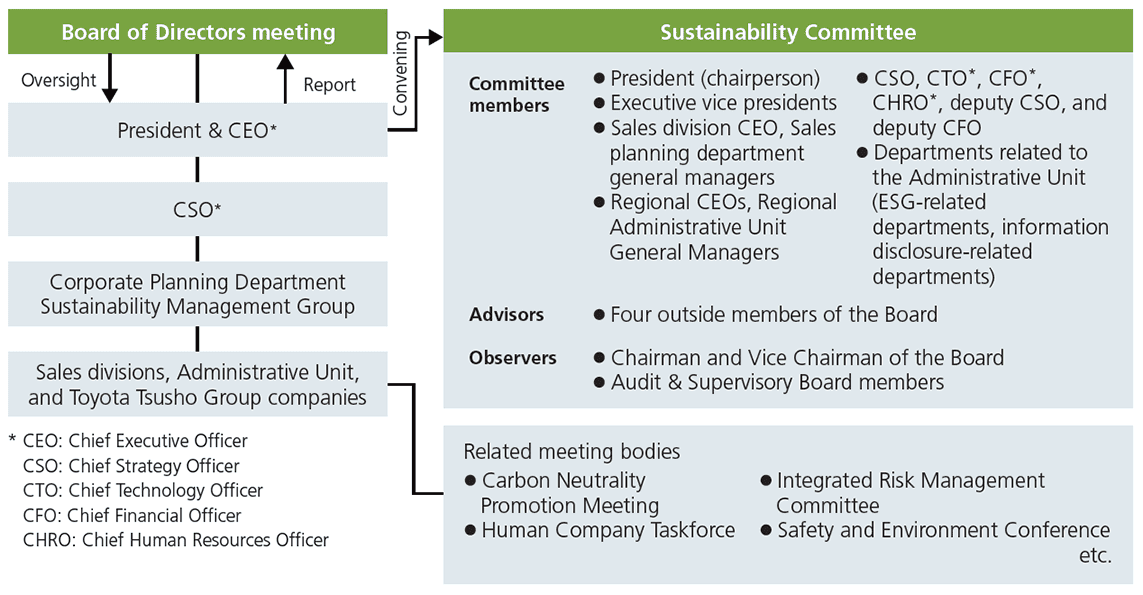
Human Rights Policy and Engagement Activities with Stakeholders
As we conduct business around the world, we consider respect for human rights based on international standards to be a fundamental foundation of our activities. We support the International Bill of Human Rights, which includes the Universal Declaration of Human Rights; the Guiding Principles on Business and Human Rights; and the ILO Declaration on Fundamental Principles and Rights at Work issued by the International Labour Organization (ILO), and we are committed to respecting human rights.
With regard to the rights of indigenous peoples, we recognize their unique cultures and histories in the countries and regions where they reside. Furthermore, we give due consideration to the rights of indigenous peoples as stipulated in the laws and regulations of those countries and regions, as well as in international norms such as the United Nations Declaration on the Rights of Indigenous Peoples.
Toyota Tsusho revised its Human Rights Policy and Behavioral Guidelines in March 2022 in response to their growing importance in society. Based on the revised policy, we assessed our human rights risks. Having identified high-risk domains, we have been conducting human rights due diligence by administering questionnaires and carrying out on-site investigations, among other measures, to mitigate these risks. In addition, with respect to human rights risks in the supply chain, we have been advancing human rights due diligence for suppliers. We analyze human rights risks from the three perspectives of business nature (business sector), location (country), and merchandise we handle, as we do for our consolidated subsidiaries, utilizing international indicators and tools. We will conduct questionnaires and on-site audits as necessary for suppliers that are identified as high risk. Furthermore, we have established a consultation desk for all stakeholders—including business partners, suppliers, local community residents, and employees of Toyota Tsusho and its domestic and overseas consolidated subsidiaries—through which we receive consultations and reports related to human rights and labor issues (grievance mechanism). Through these efforts, we will identify negative human rights impacts and work to prevent or mitigate them.
The Toyota Tsusho Group supports the Keidanren Initiative for Biodiversity Conservation and carries out a variety of activities in cooperation with local governments to help reduce biodiversity loss. In addition, in mining industry in which we conduct business, we conduct environmental impact assessments in the business planning stage and during the operation, in accordance with national and local laws where we conduct business as well as international arrangements, formulate plans for mine closures in the future, perform rehabilitation and take other measures as necessary, and work to minimize the impacts on local environments and society.
Strategy
[1] Selection of Business Operations for Assessment and Analysis in Line with the LEAP Approach
The Toyota Tsusho Group operates a wide variety of businesses—including manufacturing, distribution, sales, and operations—across approximately 130 countries and regions worldwide. In the fiscal year ended March 31, 2024, to gain a comprehensive understanding of the Group’s interfaces with nature across its businesses and sites, we undertook the Scoping Phase of the LEAP approach. By using the TNFD-recommended tool ENCORE*4, we assessed dependencies and impacts in both the upstream of the value chain and direct operations.
- *4ENCORE: A tool used to assess the materiality of nature-related dependencies and impacts in a company’s sector (as of end-May 2024).

In the fiscal year ended March 31, 2025, we narrowed the scope to direct operations and conducted evaluations and analyses in line with the LEAP approach, narrowing down the businesses—taking into account the ENCORE assessment results and factors such as scale of revenue—to those considered priorities for evaluation and action for the Group, and identified seven businesses as the selected targets.

[2] Assessing Nature-related Dependencies, Impacts, Risks and Opportunities
Dependencies and Impacts by Business
We analyzed the detailed operations of relevant sites within the seven selected businesses. We then organized information on their dependencies and impacts on surrounding natural ecosystems, along with associated risk factors, existing measures, and future plans.
In addition, by combining the identified risk factors with assessments of the natural conditions around the evaluated sites, we identified those sites that require particular attention in light of their surrounding environments (“sites requiring attention based on surrounding natural environments”). (For details of the specific evaluation methods, please refer to “Risk and Impact Management.”)
Furthermore, with respect to the value chain, we also assessed dependencies and impacts using ENCORE for upstream segments, which are considered to have greater dependencies and impacts than direct operations.
Nature-related Risks and Opportunities within the Group
Based on the assessment of dependencies and impacts on nature, we identified risks and opportunities related to nature within the direct operation of the seven businesses, in accordance with the risk and opportunity categories defined by the TNFD.

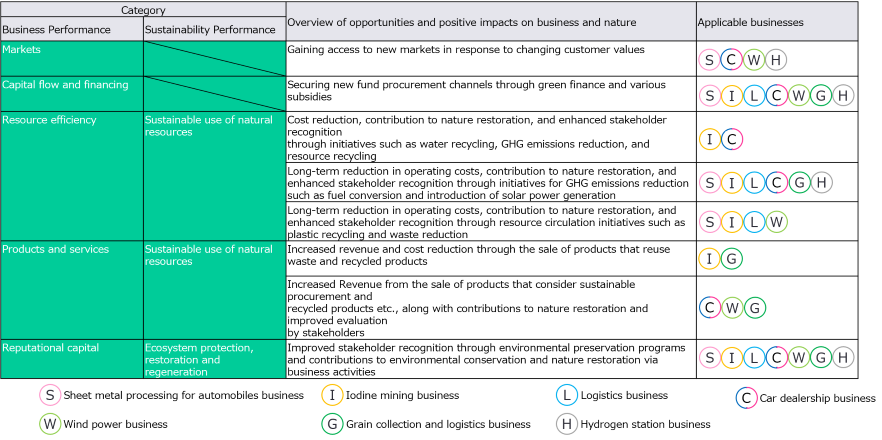
[3] Strategic Initiatives
Toyota Tsusho is committed to “passing on a better Earth to the children of the future” as its mission. To this end, the company is broadening its perspective from carbon neutrality (CN) to nature positive (NP), aiming to create more comprehensive environmental value.
This “CN&NP” initiative lies at the core of the Toyota Tsusho Group’s sustainable growth strategy and underpins all of its business activities. In particular, the circular economy (CE) businesses, including renewable energy and resource recycling businesses, in which the Group excels, are vital means of realizing CN&NP and serve as key sources of value creation. In its role as “the world’s leading circular economy provider,” the Group promotes co-creation with diverse stakeholders, including those in supply chains, consumers, and local communities. Through five Working Groups (5WGs) that integrate internal and external capabilities, the Group generates value from both environmental and economic perspectives, offering attractive growth opportunities to society.
Going forward, as a good corporate citizen, the Group will continue to advance CN, CE, and NP in an integrated manner, strive to resolve environmental issues, and contribute to the realization of a sustainable society, fulfilling its responsibility to pass on a better Earth to the children of the future.
Risk and Impact Management
[1] Process for Identifying Dependencies, Impacts, Risks, and Opportunities
To identify dependencies and impacts on nature, as well as related risks and opportunities in its business activities, the Toyota Tsusho Group has adopted the LEAP approach recommended by the TNFD.
In the fiscal year ended March 31, 2024, as part of the Scoping Phase, we assessed the significance of biodiversity and the state of physical water stress around major business sites, and evaluated dependencies and impacts on nature in the selected businesses. In the fiscal year ended March 31, 2025, based on the results of the Scoping Phase, we narrowed down the target businesses and conducted analyses under the LEAP approach for seven businesses.

- Scoping
For 40 businesses, we assessed dependencies and impacts on nature in both upstream value chains and direct operations by using ENCORE (as of end-May 2024). Based on the results of this assessment and factors such as scale of revenue, we narrowed down the businesses to those considered priorities for evaluation and action for the Group, and selected seven businesses as the subjects of analysis in line with the LEAP approach.
- Locate
From among the business sites of each selected business, we identified evaluation sites taking into account factors such as scale of revenue, and assessed the natural conditions surrounding each site. Commonly across all businesses, we used IBAT, Aqueduct, and Global Forest Watch to confirm characteristics and considerations of the surrounding natural environments in terms of four criteria: “biodiversity importance,” “ecosystem integrity,” “rapid decline in ecosystem integrity,” and “physical water risk.”
- Evaluate
In addition, through questionnaire surveys and interviews, we investigated the operations of each business and identified dependencies and impacts on nature as well as risk factors anticipated from those dependencies and impacts.
- Assess
By combining the dependencies, impacts, and risk factors identified in the Evaluate phase with the assessments of surrounding natural conditions conducted in the Locate phase, we evaluated the degree of each risk factor for every target site. Sites that had one or more risk factors assessed as “high” were identified as “sites requiring attention based on surrounding natural environments.”
Furthermore, taking into account the identified risk factors, we identified initiatives that represent opportunities for each business from both business performance and sustainability performance perspectives. - Prepare
For the identified risks and opportunities, we will set goals for mitigating risks and capturing further opportunities, working with the relevant divisions and departments, and will examine appropriate indicators and targets.
[2] Risk Management Process
Integrated Risk Management Committee
Nature-related risks identified through this analysis are discussed at the Sustainability Committee and the Safety and Environmental Conference, and the outcomes of these discussions are reflected in the formulation of business strategies and activities of each division, and are properly managed. As part of efforts to assess the status of global risk management, we have defined the ten risk items to highly focus on. Environmental management is positioned as one of these items and is incorporated into the company-wide risk management process. In the fiscal year ending March 31, 2026, we plan to update our management items and revise them into an environmental risk management process that also incorporates biodiversity perspectives.
Environmental Management System
We have acquired ISO 14001, the international standard for environmental management systems, and conducts environmental internal audits by headquarters at domestic and overseas consolidated subsidiaries subject to the certification once every three years.
For details of the Group’s risk management framework, please refer to the website below.
Investments and Loans
Toyota Tsusho’s officers participate in various meetings to confirm the impacts that our investment activities have on ESG: The executive vice presidents, CSO, and CFO*5 take part in the Investment and Loan Committee; the deputy CSO and deputy CFO in the Investment and Loan Meeting; and the president & CEO, executive vice presidents, CSO, CFO, and general manager of the Corporate Planning Department in the Investment Strategy Meeting. Projects that meet or exceed certain requirements and are submitted to the Investment and Loan Committee or the Investment and Loan Meeting are required to undergo a preliminary assessment of their impacts on natural capital. This assessment confirms conditions related to surrounding biodiversity, as well as items such as soil contamination, air pollution, water pollution, water risks, noise and vibration, odors, industrial waste, flammable hazardous materials, and toxic chemical substances.
- *5CFO: Chief Financial Officer
Metrics and Targets
Global Core Disclosure Metrics under the TNFD
The Toyota Tsusho Group is working to enhance the disclosure of indicators, including the use of quantitative KPIs for material issues related to sustainability, including nature-related challenges. With regard to the global core disclosure metrics defined by the TNFD, they are as follows.
Going forward, the Group will continue to expand disclosure of relevant indicators and enhance transparency around its targets and progress toward achieving them.
| Metric no. | Drivers of Nature Change |
Metrics | Contents of Disclosure |
Scope of Disclosure | Current Disclosure / Response Status |
|---|---|---|---|---|---|
| - | - | GHG emissions | GHG emissions (Scope1,2,3) |
Toyota Tsusho, domestic and overseas consolidated subsidiaries | |
| C2.1 | Pollution, pollution removal |
Wastewater discharges |
|
Toyota Tsusho, domestic and overseas consolidated subsidiaries | |
| C2.2 | Waste generation and disposal |
|
Toyota Tsusho (non-consolidated) and domestic consolidated subsidiaries | ||
| Industrial waste: Recycled and non-recycled volumes | Toyota Tsusho (excluding waste sold for value and construction waste as contractor) | ||||
| C2.4 | Non-GHG air pollutants |
|
Consolidated subsidiary
|
||
| C3.0 | Resource use and resource replenishment | Water withdrawal and consumption from areas of water scarcity | Water usage (facilities with significant impacts) | Sites defined as “facilities with significant impacts” |
| Metric no. | Category | Metrics | Contents of Disclosure |
|---|---|---|---|
| C7.2 | Risks | Details and amounts of significant fines, penalties, and litigation incurred during the fiscal year due to negative nature-related impacts | No fines, penalties, or litigation have occurred |
Future Outlook for TNFD
Going forward, among the seven businesses targeted in the fiscal year ended March 31, 2025, we will deepen our evaluations and analyses for those businesses considered to have higher dependencies and impacts on nature, such as those involving land development processes and upstream supply chains.
In addition, as a trading company engaged in a wide variety of businesses, we will advance the examination of company-wide indicators and targets, enhance disclosures in line with the TNFD recommendations, and further promote initiatives toward nature positive.
Specific Actions
Toyota Tsusho Group companies conduct business in accordance with the Environmental Policy.
New Business
With regard to new investment projects, we conduct research and assessments prior to investment to assess the overall environmental impact of the project including preservation of forests and biodiversity and the effective use of resources, energy and water. We take action to protect the environment and reduce environmental burdens and achieve compatibility between biodiversity and business activities.
See "Use of Thinned Trees for Biomass Power Generation"
Existing Business
In order to mitigate pollution risks pertaining to our existing businesses, we have introduced an environmental risk assessment framework under which we quantitatively assess both pollution risks for each facility and management levels at each work site. We also conduct risk assessments including biodiversity of existing businesses by performing internal audits of environmental management systems, which are a part of our ISO 14001 activities. We conduct environmental compliance evaluations twice yearly and double-check the state of priority environmental compliance status through both internal and external audits.
Use of Thinned Trees for Biomass Power Generation
Case Study 1: Biomass power generation
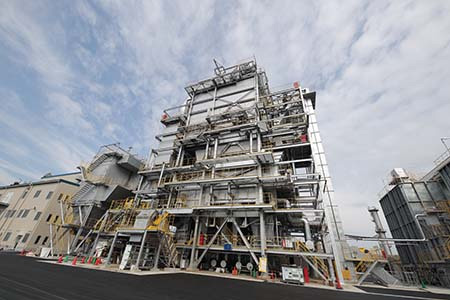
Ehime Forest Generation, LLC, established by Ene-Vision Co., Ltd., a Group company, constructed and commenced commercial operation of the Matsuyama Biomass Power Plant, a wood biomass power plant, on April 1, 2018. The power plant was constructed on an approximately 30,000 m2 site in Matsuyama City, Ehime Prefecture. It is the first wood biomass power plant in Ehime Prefecture and uses only wood biomass to generate 12.5 MW of electric power for sale using the Feed-in Tariff (FIT) system. The power plant cooperates with local forestry cooperatives to procure raw materials from trees that were thinned to support healthy forest development. The use of energy that is clearly traceable and is generated locally for local consumption achieves stable supplies and contributes to the preservation of biodiversity. In combination with Gotsu Biomass Power Plant, operated by Shimane Forest Generation, LLC in Gotsu City, Shimane Prefecture, total biomass power output is 25.2 MW.
Toyota Tsusho is also promoting business that contributes to global environmental conservation, forestry and regional revitalization through the production of saplings.
Sapling production, which was 1.6 billion saplings each year at its peak, has currently declined sharply to 60 million per year. As a result, Japan's reforestation rate has fallen to about 30%.
In partnership with the Miyakonojo Forest Owners Association, in a district of Kyushu where the shortage of saplings is particularly acute, the company has set up a system for production of local mountain saplings (cedar saplings) in the region in Miyakonojo city, Miyazaki Prefecture. In fiscal 2020, it established a system for producing 250,000 cedar saplings per year.
The company also promotes wood chip biomass fuel supply business. It is contributing to Japan's reforestation rate through sapling production, and making efforts to build a sustainable supply chain in biomass energy.
Participation in Biodiversity-Related Certification Programs
The Toyota Tsusho Group systematically assesses biodiversity risks using ISO 14001 environmental management systems and environmental management rule books and takes action to mitigate identified risks.
We also participate in biodiversity-related certification programs as a part of those efforts.
Case Study 2: Tuna Dream Goto Receives SCSA Certification
In conjunction with recent global economic growth, demand for bluefin tuna has been increasing rapidly, and overfishing resulted in bluefin being considered for inclusion on the Red List.
Toyota Tsusho partnered with Kinki University, which created the world's first successful complete bluefin tuna cultivation, to establish and operate Tuna Dream Goto, the world's first commercial complete bluefin tuna cultivation venture.
The business has acquired certification under the nursery stock certification program of the Seedlings Council for Sustainable Aquaculture (SCSA), a nonprofit organization.
The SCSA conducts on-site confirmations and peer viewings by experienced academics and obtains public comments on assessment reports to prepare a final report and make a determination whether certification can be granted.
With SCSA certification, Tuna Dream Goto can state to consumers that its fish are cultivated using artificial stocks in order to preserve natural fish (a natural resource). In addition, complete histories from parent to egg, fingerling, fry, and adult fish are maintained, making it possible to ensure traceability and safety right up to the products.
Toyota Tsusho has also acquired chain of custody (COC) certification from the SCSA as the distributor of Tuna Dream Goto Bluefin tuna.
Mitigating Loss of Biodiversity
Toyota Tsusho engages in sustainable business activities. The preservation of biodiversity is emphasized as a standard of sustainability.
We work to determine impacts of our business on biodiversity including the status of endangered species living in the vicinity of our business sites and specified information in protected areas, and we undertake business development with risk mitigation in mind. We see the preservation of biodiversity as a positive and the loss of biodiversity as a negative, and we conduct environmental risk assessments to mitigate losses. In cases where there are negative impacts on ecosystems, we take measures to offset those impacts.
Case Study 3: Eurus Energy Holdings Corporation
Responses to Biodiversity Risks in the Wind Power Business
Eurus Energy Holdings Corporation, a renewable energy power generation business in the Toyota Tsusho Group, conducts environmental assessments at the pre-project stage and selects sites for the installation of power generating facilities based on the assessment results and projected impact on biodiversity. Environmental protection measures have also been taken, including efforts to avoid bird strikes (birds colliding with windmills) based on expert advice (such as by increasing wind turbine visibility for birds), and transplanting of precious plants. Furthermore, following the start of operations, Eurus Energy Holdings conducts thorough post-operation surveys and environmental monitoring to confirm the validity of the environmental assessment results and verify the effectiveness of the environmental conservation measures.
Case Study 4: Afforestation in Brazil

Amid the great concern over deforestation in Brazil, we have contributed to afforestation on our own land and nearby private land as part of our community activities. We have planted 1,000 trees every year since 2007, reaching 20,000 trees in total.
Case Study 5: Initiatives toward handling of soybeans in the Amazon biome and stopping destruction of Brazil's forests
As international concern about environmental conservation in the Amazon increases, to maintain and expand business, it is essential to avoid dealing in goods that are produced in conjunction with deforestation and other such practices.
The Toyota Tsusho Group conducts business in Brazil through NOVAAGRI INFRA-ESTRUTURA DE ARMAZENAGEM E ESCOAMENTO AGRÍCOLA S.A. (NovaAgri), which has developed grain infrastructure business including grain warehouses, railway shipment facilities, and export terminals in central and northeastern Brazil. The Moratoria da Soja is an initiative launched by industry associations and their member corporations to enable sustainable production of soybeans while preventing destruction of forests in Brazil by stopping trading from areas in which deforestation of the Amazon biome has taken place. In line with the Moratoria da Soja initiative, we check producer lists and the following standards and conduct business based on structures for suspending trade with applicable producers.
- Moratorium lists regularly presented by grain export associations (list of producers with whom trading is prohibited)
- Names of producers that have committed environmental violations, published by the Brazilian Institute of Environment and Renewable Natural Resources (IBAMA)
- Whether there are any lawsuits for environmental violations against the producers in local and federal courts
- Whether the area is registered as an environmental protection area or indigenous settlement
External Collaboration
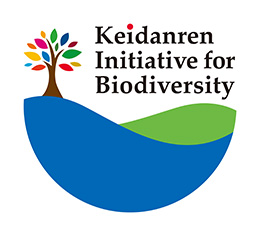
Support of the Keidanren Initiative for Biodiversity Conservation
Toyota Tsusho Corporation supports the Keidanren Initiative for Biodiversity Conservation*.
* The Keidanren Initiative for Biodiversity Conservation is a group of companies and organizations that are working on several of the seven items listed in the “Declaration of Biodiversity by Keidanren and Action Policy (Revised Edition)” or that support the whole idea and purpose of the initiative. Logos and future activity policies/examples of supporting companies and organizations are posted on a special website (Japanese/English) to introduce and promote them domestically and overseas.
CDP (Forests)
Since 2017, we have been responding to the CDP questionnaire on forests (soy and timber), a global information disclosure program regarding corporate timber. Since 2018, we have further expanded the scope of disclosure to include soy, timber, and palm oil, and are actively working to disclose information.
Toyota Tsusho Group undertake various measures in cooperation with local governments to reduce the loss of biodiversity.
Case Study 1
Toyota Adria d.o.o. cooperated with Toyota vehicle dealers in Slovenia and Serbia to hold three events in each country last year. Eco-school activities were conducted at elementary schools in the region of each dealer.
In addition, each time a hybrid vehicle is sold, one tree is planted in an area that needs greenery in Slovenia. A total of approximately 500,000 trees were planted through the three events, in which 50 staff members and approximately 200 children participated. (Similar activities were also conducted in Croatia, Serbia, and Bosnia.)
Also in Slovenia, an H2 student educational program was initiated as a part of the Zero Emission Corridor program conducted in collaboration with the Faculty of Logistics at the University of Maribor. Students in education classes at high schools in Slovenia designed, assembled, and drove hydrogen Lego cars, learning about a circular economy and the importance of future clean technologies (electrified vehicles, CO2 reduction, hydrogen technologies).
Case Study 2
Participation in Cleanup Campaign in Fujimae-Higata, a registered site under the Ramsar Convention
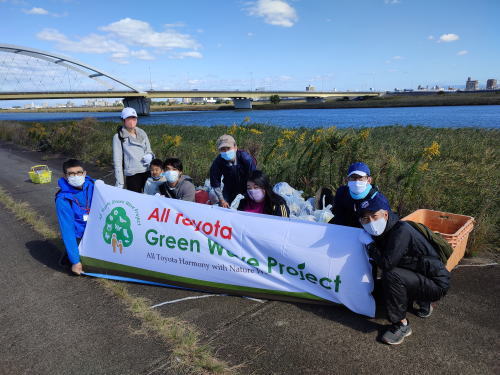
Participation in Cleanup Campaign in Fujimae-Higata, a registered site under the Ramsar Convention Tidal flats spread out in the Fujimae district of Minato-ku in Nagoya City, and Toyota Tsusho participates in a cleanup campaign to preserve the environment of Fujimae-Higata, a registered site under the Ramsar Convention.
In the fiscal year ended March 31, 2024, a total of 27 employees and family members from Toyota Tsusho and Group companies participated.
It is located close to the Nagoya head office and has the feel of an urban oasis for wildlife. About 60 different species of waterfowl are observed in Fujimae-Higata each year, with about 10,000 ducks and about 3,000 sandpipers visiting.
However, Fujimae-Higata and the nearby shore are covered by petrochemical waste including plastic bottles and bags and styrene foam carried from upstream. In order to protect this precious environment and ecosystem, Toyota Tsusho works with the Ecostock Action Committee, Tokigawa-Shonaigawa Distribution Network, Fujimae-Higata Protection Association, Riverside Heroes Tajimi Fish Association, and other citizens groups, Aichi Prefecture, Nagoya City, and other companies to conduct preservation activities.
